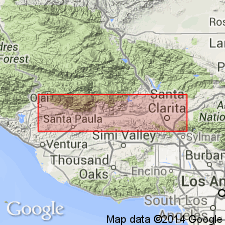
- Usage in publication:
-
- Fernando formation
- Modifications:
-
- Original reference
- Dominant lithology:
-
- Conglomerate
- Sandstone
- Clay
- AAPG geologic province:
-
- Los Angeles basin
Summary:
Fernando formation. A variable series of conglomerates, sandstones, and arenaceous clays; thickness 1,500 to 6,000 feet and possibly several thousand feet more. Fernando is term applied by Homer Hamlin a number of years ago, on unpublished maps, to include the siliceous shale skirting the sides of San Fernando Valley, Los Angeles County, southern California, which is general equivalent of all post-Modelo and pre-Saugus beds in Santa Clara province. Unconformably overlies Modelo formation in Santa Clara district and Puente formation in Puente Hills region and Los Angeles district. Unconformably underlies Pleistocene sand and gravel. [Age is early Pleistocene and Pliocene.]
Source: US geologic names lexicon (USGS Bull. 896, p. 727).

- Usage in publication:
-
- Fernando group*
- Modifications:
-
- Revised
- AAPG geologic province:
-
- Los Angeles basin
Summary:
Fernando group. Restricted to post-Miocene beds and divided into two formations, Saugus formation (2,000 feet thick) above and Pico formation (4,000 feet thick) below. Both of these formations are present at Fernando type locality, and are separated by an unconformity. Is unconformably overlain by Pleistocene terrace deposits and rests unconformably on Modelo formation. [Recognized in Los Angeles and Ventura Counties, southern California.] Fossils indicate it is early Pliocene, late Pliocene, and early Pleistocene age.
Source: US geologic names lexicon (USGS Bull. 896, p. 727).
For more information, please contact Nancy Stamm, Geologic Names Committee Secretary.
Asterisk (*) indicates published by U.S. Geological Survey authors.
"No current usage" (†) implies that a name has been abandoned or has fallen into disuse. Former usage and, if known, replacement name given in parentheses ( ).
Slash (/) indicates name conflicts with nomenclatural guidelines (CSN, 1933; ACSN, 1961, 1970; NACSN, 1983, 2005, 2021). May be explained within brackets ([ ]).

